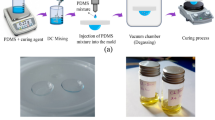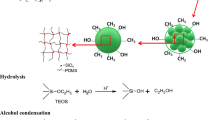Abstract
Biocompatible polymers such as poly(vinyl pyrrolidone) (PVP) are used to prepare hydrogels for biomedical applications, optical applications, cosmetic and smart medical contact lenses, and many other applications. However, the commercial PVP lenses available today are optically poor, and wearers of PVP medical contact lenses typically experience spherical, coma, astigmatism, and chromatic aberrations due to light dispersion when the pupil is opened at 2.50 mm. In this work, three contact lenses were prepared by doping PVP hydrogel with 0.1%, 0.5%, and 1% by weight of laboratory-manufactured silver nanoparticles (Ag NPs). This work demonstrates the evaluation of vision correction through each lens and the effect of changing the concentration of Ag NPs on its refractive index. The simulation included the design and simulation of an aberrated human eye based on the Liou and Brennan model and the insertion of the contact lenses for vision correction using the ZEMAX optical design program. The resulting refractive index of one PVP-Ag lens was relatively high at 532 nm = 1.545, leading the lens to guide light rays into a small spot of 3.983 µm root mean square and a highest image contrast (lowest MTF curve degradation) of 0.863 ± 0.027 at 20 cycles/mm.







Similar content being viewed by others
Data availability
Data will be made available on request.
References
N. Tahhan, T.J. Naduvilath, C. Woods, E. Papas, Review of 20 years of soft contact lens wearer ocular physiology data. Contact Lens Anterior Eye 45(1), 1–18 (2022). https://doi.org/10.1016/j.clae.2021.101525
N. Efron, Contact Lens Practice E-Book, 3rd edn. (Elsevier, Amsterdam, 2016)
K.R. Steele, H. Wagner, N. Lai, A.B. Zimmerman, Gas-permeable contact lenses and water exposure: practices and perceptions. Optom. Vis. Sci. 98(3), 258–265 (2021). https://doi.org/10.1097/OPX.0000000000001660
R. Sinha, V.K. Dada, Evolution of contact lenses, in Textbook of Contact Lenses, JP Medical Ltd (2017), 3–10
J.S. Wolffsohn et al., CLEAR—evidence-based contact lens practice. Contact Lens Anterior Eye 44(2), 368–397 (2021). https://doi.org/10.1016/j.clae.2021.02.008
D.Y. Kim, H. Park, Y.I. Park, J.H. Lee, Polyvinyl alcohol hydrogel-supported forward osmosis membranes with high performance and excellent pH stability. J. Ind. Eng. Chem. 99, 246–255 (2021). https://doi.org/10.1016/j.jiec.2021.04.040
M. Contardi et al., Electrospun polyvinylpyrrolidone (PVP) hydrogels containing hydroxycinnamic acid derivatives as potential wound dressings. Chem. Eng. J. (2021). https://doi.org/10.1016/j.cej.2020.128144
P.J. Bora, A.G. Anil, P.C. Ramamurthy, Y.H. Lee, Chemically room temperature crosslinked polyvinyl alcohol (PVA) with anomalous microwave absorption characteristics. Macromol. Rapid Commun. 42(10), 2000763 (2021). https://doi.org/10.1002/marc.202000763
P. Boonsuk, K. Kaewtatip, S. Chantarak, A. Kelarakis, C. Chaibundit, Super-tough biodegradable poly(vinyl alcohol)/poly(vinyl pyrrolidone) blends plasticized by glycerol and sorbitol. J. Appl. Polym. Sci. 135(26), 1–8 (2018). https://doi.org/10.1002/app.46406
N. Rescignano et al., PVA bio-nanocomposites: a new take-off using cellulose nanocrystals and PLGA nanoparticles. Carbohydr. Polym. 99, 47–58 (2014). https://doi.org/10.1016/j.carbpol.2013.08.061
F.A. Maulvi et al., Novel poly(vinylpyrrolidone)-coated silicone contact lenses to improve tear volume during lens wear: in vitro and in vivo studies. ACS Omega 5(29), 18148–18154 (2020). https://doi.org/10.1021/acsomega.0c01764
M.S.B. Husain, A. Gupta, B.Y. Alashwal, S. Sharma, Synthesis of PVA/PVP based hydrogel for biomedical applications: a review. Energy Sources Part A Recovery Util. Environ. Effects 40(20), 2388–2393 (2018). https://doi.org/10.1080/15567036.2018.1495786
D. Kharaghani et al., Development of antibacterial contact lenses containing metallic nanoparticles. Polym. Test. (2019). https://doi.org/10.1016/j.polymertesting.2019.106034
L. Mohammed Shaker, A.A. Alamiery, M. Takriff, W. Nor Roslam Wan Isahak, Nano-titanium oxide in polymeric nano-titanium oxide in polymeric contact lenses: short communication. Nanomanufacturing 2(3), 71–81 (2022). https://doi.org/10.3390/nanomanufacturing2030006
B. Cai, T. Kaino, O. Sugihara, Sulfonyl-containing polymer and its alumina nanocomposite with high Abbe number and high refractive index. Opt. Mater. Express 5(5), 1210 (2015). https://doi.org/10.1364/OME.5.001210
A. Sung, T. Kim, Physical properties of ophthalmic hydrogel polymer containing zinc oxide nanoparticles. J. Chosun Nat. Sci. 6(2), 76–81 (2013). https://doi.org/10.13160/ricns.2013.6.2.76
I. Armentano et al., Nanocomposites based on biodegradable polymers. Materials (Basel) 11(5), 1–27 (2018). https://doi.org/10.3390/ma11050795
S. Bayda, M. Adeel, T. Tuccinardi, M. Cordani, F. Rizzolio, The history of nanoscience and nanotechnology: from chemical-physical applications to nanomedicine. Molecules 25(1), 1–15 (2020). https://doi.org/10.3390/molecules25010112
J. Jeevanandam, A. Barhoum, Y.S. Chan, A. Dufresne, M.K. Danquah, Review on nanoparticles and nanostructured materials: history, sources, toxicity and regulations. Beilstein J. Nanotechnol. 9(1), 1050–1074 (2018). https://doi.org/10.3762/bjnano.9.98
H. Mirzajani, F. Mirlou, E. Istif, R. Singh, L. Beker, Powering smart contact lenses for continuous health monitoring: recent advancements and future challenges. Biosens. Bioelectron. 197, 113761 (2022). https://doi.org/10.1016/j.bios.2021.113761
H. Boulaiz et al., Nanomedicine: application areas and development prospects. Int. J. Mol. Sci. 12(5), 3303–3321 (2011). https://doi.org/10.3390/ijms12053303
A.J. Clasky, P.Z. Chen, W. Brooks, K. McCabe, F.X. Gu, Polymer co-coating of gold nanoparticles enables their integration into contact lenses for stable, selective ocular light filters. Adv. Mater. Interfaces 9(30), 1–11 (2022). https://doi.org/10.1002/admi.202201549
J. Kopeĉek, Hydrogels: from soft contact lenses and implants to self-assembled nanomaterials. J. Polym. Sci. Part A Polym. Chem. 47(22), 5929–5946 (2009). https://doi.org/10.1002/pola.23607
L.M. Shaker, A.A. Al-Amiery, A.A.H. Kadhum, M.S. Takriff, Manufacture of contact lens of nanoparticle-doped polymer complemented with zemax. Nanomaterials 10(10), 1–11 (2020). https://doi.org/10.3390/nano10102028
L.M. Shaker, A. Alamiery, M. Takriff, W.N.R. Wan-Isahak, Novel blue-wavelength-blocking contact lens with Er3+/TiO2 nps: manufacture and characterization. Nanomaterials 11(9), 1–12 (2021). https://doi.org/10.3390/nano11092190
W.J. Smith, Modern Optical Engineering: The Design of Optical Systems, 2nd edn. (McGraw Hill, New York, 2007)
J.M. Geary, Introduction to Lens Design With Zemax, 2nd edn. (Willmann-Bell, Richmond, 2002)
P. Scherrer, Bestimmung der inneren Struktur und der Größe von Kolloidteilchen mittels Röntgenstrahlen, in Kolloidchemie Ein Lehrbuch. ed. by R. Zsigmondy (Springer, Berlin, 1912), pp.387–409. https://doi.org/10.1007/978-3-662-33915-2_7
D.A. Atchison, L.N. Thibos, Optical models of the human eye. Clin. Exp. Optom. 99(2), 99–106 (2016). https://doi.org/10.1111/cxo.12352
H.L. Liou, N.A. Brennan, Anatomically accurate, finite model eye for optical modeling. J. Opt. Soc. Am. A Opt. Image Sci. Vis. 14(8), 1684–1695 (1997). https://doi.org/10.1364/josaa.14.001684
S. Dua, U.R. Acharya, E.Y.K. Ng, Computational Analysis of the Human Eye with Applications (World Scientific, Singapore, 2011)
G. Westheimer, Image quality in the human eye. Opt. Acta Int. J. Opt. 17(9), 37–41 (1970). https://doi.org/10.1080/713818355
R.E. Fischer, B. Tadic-Galeb, Optical System Design (McGraw-Hill, New York, 2000)
K. Okitsu, UV–VIS spectroscopy for characterization of metal nanoparticles formed from reduction of metal ions during ultrasonic irradiation, in UV-VIS and Photoluminescence Spectroscopy for Nanomaterials Characterization. ed. by C. Kumar (Springer, Berlin, 2013), pp.151–177
K.C. Lee, S.J. Lin, C.H. Lin, C.S. Tsai, Y.J. Lu, Size effect of Ag nanoparticles on surface plasmon resonance. Surf. Coat. Technol. 202(22–23), 5339–5342 (2008). https://doi.org/10.1016/j.surfcoat.2008.06.080
V.K. Sharma, R.A. Yngard, Y. Lin, Silver nanoparticles: Green synthesis and their antimicrobial activities. Adv. Colloid Interface Sci. 145(1–2), 83–96 (2009). https://doi.org/10.1016/j.cis.2008.09.002
H. Feng, Z. Feng, L. Shen, A high resolution solid-state n.m.r. and d.s.c. study of miscibility and crystallization behaviour of poly(vinyl alcohol) poly(N-vinyl-2-pyrrolidone) blends. Polymer (Guildf) 34(12), 2516–2519 (1993). https://doi.org/10.1016/0032-3861(93)90581-T
M. Kalloniatus, C. Luu, Visual acuity by Michael Kalloniatis and Charles Luu, in The Organization of the Retina and Visual System. ed. by R. Nelson, E. Fernandez (Webvision, Mudgeeraba, 2007)
B.D. Guenther, D.G. Steel, Encyclopedia of Modern Optics (Academic Press, Cambridge, 2018), pp.1–5
R.M. Hammer, B.A. Holden, Spherical aberration of aspheric contact lenses on eye. Optom. Vis. Sci. 71(8), 522–528 (1994). https://doi.org/10.1097/00006324-199408000-00006
N. Hampp, C. Dams, T. Badur, H. Reinhardt, nanoparticles for enhancing the refractive index of hydrogels for ophthalmological applications. Proc. SPIE 10078, 100780I (2017). https://doi.org/10.1117/12.2256296
M. Ghanipour, D. Dorranian, Effect of Ag-nanoparticles doped in polyvinyl alcohol on the structural and optical properties of PVA films. J. Nanomater. 2013, 1–11 (2013). https://doi.org/10.1155/2013/897043
S. Marcos, S.A. Burns, P.M. Prieto, R. Navarro, B. Baraibar, Investigating sources of variability of monochromatic and transverse chromatic aberrations across eyes. Vis. Res. 41(28), 3861–3871 (2001). https://doi.org/10.1016/S0042-6989(01)00133-X
K. Koev et al., Application of silver antibacterial nanolayers for hard contact lenses coating. IOP Conf. Ser. Mater. Sci. Eng. 618(1), 012028 (2019). https://doi.org/10.1088/1757-899X/618/1/012028
L.M. Shaker, A.H. Al-hamdani, A.A. Al-amiery, Nano-particle doped polymers to improve contact lenses optical quality. Int. J. Nanoelectron. Mater. 13(1), 19–30 (2020)
Author information
Authors and Affiliations
Contributions
AA and LMS did conceptualization and methodology and writing—original draft preparation; LMS gave software and done formal analysis; MST and WNRWI validated the study; AA and SA performed investigation; WNRWI and SA have given resources; AA and WKAl-A done writing—review and editing; MST and WNRWI visualized the study; AA, MST and WNRWI did supervision; AA, MST and WNRWI contributed to project administration; WNRWI and WKAl-A performed funding acquisition. All authors have read and agreed to the published version of the manuscript.
Corresponding authors
Ethics declarations
Conflict of interest
There is no conflict of interest.
Additional information
Publisher's Note
Springer Nature remains neutral with regard to jurisdictional claims in published maps and institutional affiliations.
Rights and permissions
Springer Nature or its licensor (e.g. a society or other partner) holds exclusive rights to this article under a publishing agreement with the author(s) or other rightsholder(s); author self-archiving of the accepted manuscript version of this article is solely governed by the terms of such publishing agreement and applicable law.
About this article
Cite this article
Shaker, L.M., Abdulhadi, S., Al-Azzawi, W.K. et al. Colorless poly(vinyl pyrrolidone) hydrogel contact lenses synergized with silver nanoparticles. J Opt 53, 847–856 (2024). https://doi.org/10.1007/s12596-023-01176-z
Received:
Accepted:
Published:
Issue Date:
DOI: https://doi.org/10.1007/s12596-023-01176-z




